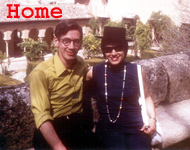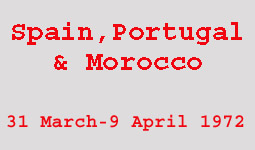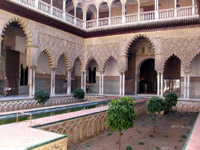Page 1 2 3 4 5 6 7 8 9 10 11 12 13 14
Tuesday, 4 April (continued). From the Alcazar we walked to the
nearby Cathedral, built beginning in 1402 on the site of the 12th century Almohad Mosque. The huge old minaret,
known as the Giralda, is now the bell tower (315 feet high). It is the largest
Catholic Cathdral in the world. (St. Peter's, though larger, is not a
cathedral.) The tomb of
Christopher Columbus is in the Cathedral (although there is some dispute about
his burial place). It also has the world’s largest altar
piece (gold over carved wood). In addition, there is another altar (1770) made of pure silver
with gold trim, that is used only
for Easter celebrations. There are also a number of paintings by Murillo, of
which the Immaculate Conception was most prominently displayed.
From the Cathedral we walked through the Santa Cruz quarter and the old Jewish quarter. Then there was a stop at a jewelry "factory." (These factories are usually just a gimmick to interest tourists. Almost all the jewelry sold in the "factory store" is made elsewhere. Also, the tour conductor gets a cut of the proceeds of sales to his group.) At 13:30 we had lunch at La Rabida (The Hermitage) Restaurant.
Then the bus headed for Cadiz. By this time Mr. Lehmann succeeded in getting his tape player to work through the bus’ sound system, and he played regional Spanish music as well as prerecorded lectures. About 16:30 we passed through Jerez de la Frontera, birthplace of sherry wine. (The British managed to corrupt "Jerez" into "sherry.") We recognized two of the three bodegas (Byass and Domencq) we had visited 23 years earlier.
[We had been in Jerez in September 1959. Rota, on the Bay of Cadiz, had been the first stop in Europe for our family when we sailed from New York to Livorno, Italy, on a Navy transport. The Navy had arranged a visit to Jerez while the ship refueled and reprovisioned. We signed up because we’d have done almost anything to get off that ship. With our four boys ranging in age from four and a half years to three months, it had been quite an experience.]
The bus arrived in Cadiz at 18:30. Cadiz is on the tip of a narrow peninsula that juts into the Atlantic. The Phoenicians had a harbor here, and the Romans expanded it into the great port of Gades. It was Columbus’ point of departure on his 1492 voyage.
We checked into the Plaza Victoria Hotel. The bus then took our tour group around the city to see the Plaza del Toro, the old city walls (even a segment of the old Roman wall), several fountains, the waterfront, the two-tone Cathedral, and the Plaza de Sevilla. (And probably a dozen other plazas; there was one every few blocks.) We had dinner at the hotel and settled in for the night.
[My original notes lists these as the places we passed through on this day: Niebla, Manzanilla, Sanlucar la Major, Espartinas, Sevilla, Los Palacios (y Villafranca), Jerez de la Frontera, El Puerto de Santa Maria, Puerto Real, San Fernando, and Cadiz.]
Page 1 2 3 4 5 6 7 8 9 10 11 12 13 14
Copyright © 2000-2023 DarrellPeck.com All rights
reserved. | |||||













